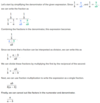Rational Expressions, Equations, and Functions Flashcards
(64 cards)
What is a ratio?
a fraction
numerator ÷ denominator
What is a rational expression?
a ratio of polynomials

What is an expression?
a combination of numbers, variables, and operations
examples:
5 + 23
4x
6x + y²
How do you multiply rational expressions?

- factor numerators and denominators (find excluded values)
- cancel
- multiply

How do you simplify rational expressions?
- combine like terms
- factor numerators and denominators
- cancel
What are excluded values?
values of x that make the denominator = 0

What is a complex fraction?
a fraction that contains a fraction in the numerator and/or denominator (a.k.a. nested fraction)

How do you simplify complex fractions?

- add or subtract fractions if necessary
- rewrite as division: numerator ÷ denominator
- rewrite as multiplication: first fraction times reciprocal of second fraction
- factor numerators and denominators
- cancel
- multiply

How do you divide rational expressions?

- rewrite as multiplication: first fraction times reciprocal of second fraction
- factor numerators and denominators (note excluded values)
- cancel
- multiply

How do you add or subtract rational expressions?

- factor denominators
- get common denominator by multiplying the numerator and denominator by any missing factors
- add or subtract the numerators; leave the denominator factored
-
simplify
- combine like terms
- factor
- cancel

What are factors?
the polynomials being multiplied
factor × factor = product
example:
(x – 2)(x + 2) = x2 – 4
What is a product?
the result of multiplying two or more polynomials
factor × factor = product
example:
(x – 2)(x + 2) = x2 – 4
When subtracting, make sure to…
…distribute the negative.
example:
5 - (x + 6) = 5 - x - 6
Dividing is the same as…
…multiplying by the reciprocal.
You can cancel only if…
…numerators and denominators are factored.
When adding or subtracting fractions, you need a…
…common denominator.
What is a quotient?
the result of dividing two or more quantities
dividend ÷ divisor = quotient
How do you factor a trinomial?
GCF(trinomial)
–and/or–
(binomial)(binomial)
“multiplies to c and adds to b”
How do you factor a binomial?
GCF(binomial)
–and/or–
Difference of Squares
How do you multiply a binomial times a binomial?
distributive property
(a + b)(c + d)
a(c + d) + b(c + d)
ac + ad + bc + bd
example:
(x + 5)(x - 3)
x(x -3) + 5(x - 3)
x2 - 3x +5x - 15
x2 + 2x - 15
How do you multiply a monomial times a binomial?
distributive property
a(b + c)
ab + ac
example:
2bd(3bc + 5ad)
6b2cd + 10abd2
What is a constant?
a number
What is a binomial?
a polynomial with two terms
What is a trinomial?
a polynomial with three terms

















